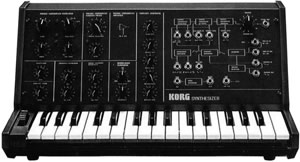Sampled Instruments
Synthesizers, Keyboards & Modules
Akai AX-73 SynthCasio CZ-101
Casio VZ-1
EDP Wasp Synth
Ensoniq SQ-1 Plus
Korg MS 10
Korg MS 20
Korg Poly-800
Novation Super Bass Station
Roland JP-8080/JP-8000
Roland Juno 1
Roland Juno 106
Roland JX-3P
Yamaha TX802
Budget Samples
Access Virus CCasio HT-6000
Cheetah MS6
Clavia Nord Lead 2X
KAWAI K1/K1m/K1r
Korg DW8000
Korg Triton
Novation Supernova II
Quasimidi Technox
Roland D 50
Roland JD800
SCI MAX / 6-Track
SIEL DK 80
Korg MS10 Synthesizer
 In the nineteen seventies sythesizers were so expensive only the very rich could afford them. Even when the first wave of monophonic synthesizers came onto the market, although they were massively cheaper than the poly synths of the day, they were still rather expensive items for the average struggling musician or wannabee pop star. In 1978 Korg released the amazing MS10 mono synth for "only" £299 along with a selection of other synthesizers and gadgets in the "MS" range which included the sought after MS20.
In the nineteen seventies sythesizers were so expensive only the very rich could afford them. Even when the first wave of monophonic synthesizers came onto the market, although they were massively cheaper than the poly synths of the day, they were still rather expensive items for the average struggling musician or wannabee pop star. In 1978 Korg released the amazing MS10 mono synth for "only" £299 along with a selection of other synthesizers and gadgets in the "MS" range which included the sought after MS20.
Sections
More About The Korg MS10
Korg MS10 Specifications
Notes About The Korg MS10
Famous Korg MS10 Users
Korg MS10 Samples
More About The Korg MS10
Today the MS10 may first appear as rather a strange beast capable of producing all manner of sci-fi sound effects and obscure instrumental sounds - although only available at one note at a time. I believe that, by todays standards, the unusual shape of the synth was rather logical in 1978. The shape is similar to the Minimoog D and some similarities can be drawn with earlier Korg synths and even the ARP2600,
The MS10 could be classed as a semi-modular synthesizer because of the very small patchbay to the right of the control panel. Unfortunately this does not actually add a great deal of options other than the most basic. The panel features CV & Gate/Trig inputs and outputs which allows the synth to be easily integrated into the modern studio. Other outputs include white and pink (duller sound) noise, two outputs from the modulation generator with a selection of waveforms, an inversion of the envelope controls and the main audio output. Modulation inputs includeOscillator frequency, PWM, Cutoff frequency, initial gain and an input for an external signal to allow processing of other sounds.
Renowned for its stranger sounds the Korg MS10 features just one oscillator and is therefore rather limited in the range of sounds it can produce. However it is the quality of those sounds that is important. The MS10 can cover most "bread and butter" mono synth sounds including pulse width modulation which was not available on its big brother the MS20. Behaviour of the sound can be difficult to foresee and, sometimes, even the smallest turns on the pots can produce disproportionate changes in timbre, especially when tinkering with the filter controls - see notes below.
Many praise the Korg MS10 for its bass sounds and its snappy envelopes and while the sound can often appear rather thin at other times it can be incredibly thick (fat, phat, phatt or whatever people choose to describe such sounds these days).
Korg MS10 Specifications
- Polyphony: Monophonic (able to play 1 note at a time)
- Oscillators: One single VCO.
- Osc Waveforms: Triangle, Ramp, Pulse and noise. White & Pink noise available from patchbay
- LFO: 1 LFO with variable waveforms
- Filter: 12db lowpass filter
- Effects: Able to PWM via patchbay
- Control: CV / Trig (Gate)
- Manufactured 1978
Korg MS10 Notes
PLEASE be very careful when using the Korg MS10 (& our samples), especially if you have the Peak (resonance) control above 7, as the synth can suddenly produce waveforms capable of damaging both your ears and your speakers at even reasonable volume levels. Wearing headphones to listen to the synth is only advisable once you have gained experience and then only at very reasonable volume levels. It is strongly advisable to place a compressor/limiter directly after the MS10 output stage to limite the risks.
As with most early analogue synths it can take half an hour or so for the circuits and components to warm up and stabalise so when using one it is best to switch it on and leave well alone for at least half an hour before tuning it - otherwise the tuning can drift. Surprisingly, once warmed up, the synth remains in tune extremely well.
Korg MS10 Famous Users
Although the MS10 sold in relatively large numbers, and no doubt appeared in a number of chart hits and album tracks of the day (and since), identifying well known users proves rather difficult. Few would be surprised to learn that the Chemical Brothers are known to have used the MS10 (what haven't they had their hands on?). Add N to (X)., Astral Projection, Autechre, Juan Atkins, JunkieXL, The Orb, SkyLab, , Sneaker Pimps, Underworld and Luke Vibert are also known to have used this synthesizer.
|
|||||||||||||||




